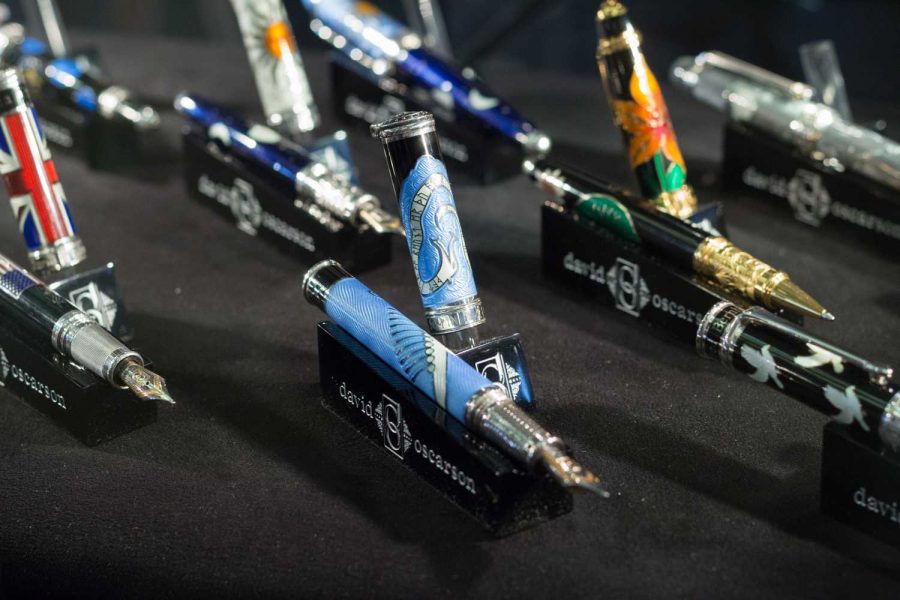Uniting in a niche
Pen enthusiasts travel to Los Angeles to share their passions at the 29th LA International Pen Show
March 7, 2017
White clouds softened the bright sunlight that fell on the Marriott Hotel in Manhattan Beach. With a camera in my bag and a few dollars in cash, I entered the establishment to discover two lines that were so long they stretched out across the lobby to a hallway on the other side. One line was for entering the show and the other was to buy tickets for it.
I walked to the back and trudged along with the others to the entrance of the 29th Los Angeles International Pen Show, one of 16 pen shows in the United States. A hotel employee holding red bags with the logos of various pen and ink manufacturers — Hugo Boss, Napkin Forever, Monteverde, Conklin and Delta — handed one to each visitor. I looked inside mine to discover a Monteverde Malibu Blue ink, along with an ink eraser and corrector.
“That’s nice of them, isn’t it?” I said to the man standing next to me. His name was Andy Sonnemaker, a fountain pen collector who restores and sells pens online. Sonnemaker has been coming to the show “on and off” since 1993 and brought with him a binder full of fountain pens. He showed a slender version of the Waterman Safety, a fountain pen with a retractable nib that had a sterling silver overlay, and a Waterman 58, a pen with a lever-filler, a filling system not found commonly today.
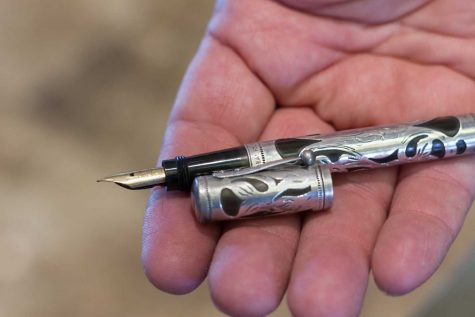
Andy Sonnemaker’s Waterman Safety 412 ½ in sterling silver
Sonnemaker occasionally rents a table at the LA show to sell pens in his collection. “The fun thing about getting a trader table or a show table is the number of people that stop and talk and the trading you can do,” Sonnemaker said.
“There’s a lot of amazing pens that standing in line like this we will never see that trade hands privately at the trading days on Thursday and Friday. Back when I could I would take days off work teaching to come down Thursday and swap pens. That’s the best way to find stuff,” Sonnemaker said. He was referring to the exclusive trader days, which are available for $55 or $65 fee, depending on the purchase date. The high price makes the trader days less packed than the $7 Sunday show and this is when the expensive and rare pens are usually traded.
We talked our way through the line and said our goodbyes once we bought the tickets. I strolled by the various tables, nudging my way through the dense wall of people. I met Rik Knablein, a former NASA employee who opened his own pen company RiKwill. “The theme of the company is sterling silver,” Knablein said. “The other theme is two pens in one. All our pens come with a fountain pen and a nib of your choice plus a rollerball section, so you can just unscrew your fountain and screw in your rollerball.”

RiKwill’s Babbage Cousins II Limited Edition, a sterling silver pen with a resin Toffee Bits veneer.
Knablein said that the rollerball section was for people who must use lower quality paper that cannot work with liquid ink. “I have a doctor client and he loves fountain pens. So at home he uses the fountain pen. When he goes to work he puts the rollerball in,” Knablein said.
One of the most attractive pens that I had the pleasure to see from Knablein’s company was the Babbage Cousins II Toffee Bits. The pen was made out of sterling silver but was covered with a layer of resin that did, as the name suggests, look like toffee, albeit in bright orange.
We spoke about introducing people to fountain pens and convincing them to join in the hobby. Knablein said that it would be very simple to do so. “A ballpoint just writes in a little round roller. But if you put in an italic bold onto a fountain pen, all of the sudden your handwriting has character to it. The downstrokes are fatter than the left and right strokes,” Knablein said. “And then the look. This is a sterling silver pen, hand engraved. A lot of my clients want to present themselves with this versus a throwaway pen.”
But an expensive pen is not a necessity. My first fountain pen was a $4 Pilot Varsity, specifically designed for students. The nib was smooth and required no pressure to write with. Long essays no longer caused fatigue or pain in my wrist and actually became enjoyable, to a limited extent. The president of the retail company Toys from the Attic, Mario A. Campa, mentioned the same pen when discussing the introduction of newcomers to the hobby. “You can buy a Pilot Varsity for $4 and see if that is an experience you like. That’s what I suggest to new people.”
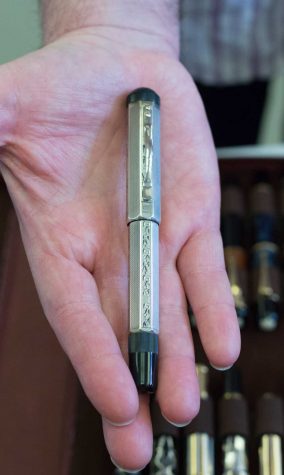
Mario A. Campa’s Patron of the Arts series Montblanc, the 25-year-old Lorenzo De Medici.
Campa’s table had a binder of pens with the familiar mountain-peak logo. I instantly recognized them as Montblanc and Campa was happy to tell me about them. “This is a nearly complete collection that I just acquired of all of the Writer series and the Patron of the Arts. Montblanc releases one per year. They started in 1992. One of my favorites is the Lorenzo De Medici. It is the very first of the Patron of the Arts. I have this one that still has the original sticker. We’re talking about a 25-year-old pen and it is in absolutely pristine condition,” Campa said.
I came upon a calligrapher, Nikola Pang, who offered his copper plating services free of charge. He wrote my name and my mother’s name and refused a tip when I offered him one. I thanked him and sauntered my way to a very curious table. Amidst the countless stacks of pens was chef and chocolatier Brandon Lee of Modern Chocolate with a variety of flavors on display. I bought one box, stuffed myself without any regrets and came back for another.
Next to Lee’s table was a display of wooden pens, a rarity in the fountain pen community as most are made of resin and acrylic. The pen maker, Ryan Krusac, began his work when he lost his pen at an airport in Mexico City. He decided to buy the pen “you see in everyone’s pocket in first class at the airport” — a Montblanc 144. “I was astounded by the cost of a fountain pen. I just thought that it would be 80 bucks,” Krusac said.
“It’s made out of acrylic. All the product that I made in textiles was made out of acrylic. It’s a $1.78 a pound. I did the math in my head and saw that there is a margin in pens. I called my wife at the airport in Mexico City. I said, ‘Honey, we’re starting a pen company.’ That was […] almost eleven years ago.”

Chef and chocolatier Brandon Lee’s chocolates on display
Krusac went down along the path of wooden pens as he wanted to “bring materials with a real value to them.” While a few of his pens have a clear finish over the wood, Krusac does not prefer this coating. “Really, my artistic philosophy is I think the writer and the pen should fuse together. The beauty of the natural finish is that it absorbs the oils from your hand.”
“I’ve got one customer, actually from here, from California, he brought [his pen] by. He just has a nervous habit [of rubbing the pen]. There’s one spot on his pen that is shiny as it can be. And I love that; his pen is completely unique,” Krusac said. And his choice has been successful. In fact, Krusac’s newest pen, the Legend, has been nominated for the Best Artisan Pen by Pen World magazine.
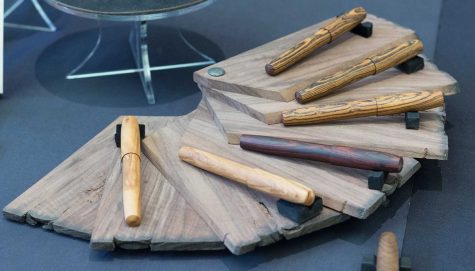
Ryan Krusac’s new line of pens called The Legend
At some point, I came upon a table whose owner had a photograph of him next to another man holding the same pens that were on display at the table. I asked the owner, pen maker Roger Cromwell, about the story behind the photograph. Cromwell informed me that the man was Harlan Ellison, the award-winning science-fiction writer, and the pens belonged to him.
“Jerry Bruckheimer, the movie producer for the Lone Ranger, I made him a fountain pen, called The Lone Ranger Pen, that I gave him as a gift,” Cromwell said. “Right after that I got a call from Harlan Ellison saying that he is friends with Jerry and he wants that same pen and he wanted me to call him. So I did and we became friends after I got him one.”
I asked how he was able to convince Ellison to give him his fountain pens, one of which was a Montblanc. “He’s got a collection of 400 pens and he wanted The Lone Ranger Pen really bad. I said, ‘Okay, that’s fine. I’ll give you The Lone Ranger Pen under one condition. I’ll give it to you half off, which was $8,500, if you let my son-in-law do an interview with you for Pen World magazine, and I can pick out pens that I want out of your collection and you’ll take a picture with me so I can prove they’re yours.’ And he goes, ‘Oh my God, is there anything else you want?’”

(Top) Harlan Ellison’s pen collection on display
(Bottom) Harlan Ellison (left) posing whilst holding his pens with Roger Cromwell (right)
Sadly, I couldn’t afford Harlan Ellison’s Montblanc, so I got away with purchasing John F. Kennedy’s campaign button that I gave to government teacher Nicholas Doom for his collection of political paraphernalia.
I walked around some more, speaking to pen collector Dan Reppert about the downfall of the Sheaffer Pen Company, trying different flexible nibs, examining tiny vintage pens that women used to wear as necklaces and generally nerding out with other pen collectors.
I bumped into the aforementioned calligrapher, Nikola Pang, later in the day. He asked what pens I purchased and once I told him I didn’t bring enough money for that, he took me to his table and gifted me a vintage calligraphy pen set by Osmiroid. “The only thing I ask is that you send me progress photos,” Pang said, and I promised him that I would.
The last table I stopped at was of David Oscarson, a luxury pen company. I had the opportunity to speak to the man himself who enthusiastically talked about his manufacturing process and company history. “I am an independent designer. I work exclusively in sterling silver, guilloché and hot enamel,” Oscarson said. By hot enamel, Oscarson means “vitreous, kiln-fired glass.” Guilloché is a pattern engraved by a hand-operated machine, commonly found in the works of “houses like the Van Cleef, Cartier and Fabregé,” the latter of which is known for their ornamental “Fabregé eggs.”
“The best way to determine a real enamel is to hold it,” Oscarson said, surprising me by nonchalantly handing over one of his pens. “You will realize that it feels cool to the touch because it is, indeed, glass […] We are the only ones really right now that are doing this.”
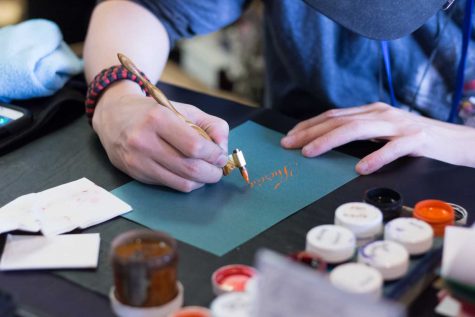
Nikola Pang writing in a show visitor’s name in copperplate calligraphy
David Oscarson’s pens start at $5,600. However, some pens ornamented with jewelry have been sold for upwards of $500,000. “It’s very rare that we make something like that, but we have done several in the past,” Oscarson said.
After speaking with Oscarson, I decided to conclude my day at the show. While I didn’t buy anything besides chocolate and the JFK campaign pin, I was happy nonetheless.
The fountain pen hobby requires a very specific personality, one that Reppert called “artistic” and “a little bit flamboyant.” Most people do not fit into this category, and ones that do may simply not have the time to maintain fountain pens. Considering the paper quality in the United States, they aren’t always practical, either.
Due to this, it is especially difficult to find someone involved in the fountain pen hobby, which made the show all the more special. The show was almost like a reunion of long lost friends whom I sorely missed. I was fascinated by the collections, tales and histories, and I was humbled by the friendliness and generosity of the community. While owning an expensive vintage flexible pen would be nice, the point of the show for me was to spend time with like-minded individuals interested in the same niche, and I am happy I was able to do just that.
